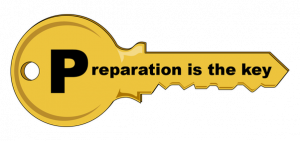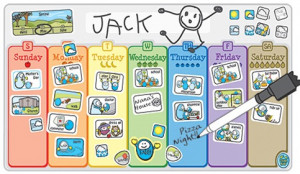Autism Series XI: The Power of ‘Preparation’ (Part 2)
Autism Series XI: The Power of ‘Preparation’ (Part 2)

The Power of ‘Preparation’- Preparation is a very strong tool that can assist an individual / a child with ASD (Autism Spectrum Disorder) to manage the ever-changing scenarios in life – be it during a session, daily life or even school. Preparation can be done in a variety of ways. Learn about some more details to prepare effectively for your child. [Get answers to the basics about ‘preparation’ in Part 1 of this series (here)]
Preparation through a calendar:
 A visual calendar of each day/date comes quite handy. It can indicate important events, people or changes of event that the child needs to be alerted about.
A visual calendar of each day/date comes quite handy. It can indicate important events, people or changes of event that the child needs to be alerted about.
A simple example can be, therapy sessions. Days therapy sessions is not to be conducted, the calendar does not have its photos. Otherwise, it does.
Preparation at home:
The questions that may come to ones’ mind for preparation at home are – where and how does preparation be done for the child, when is the best time to do so and who is the best person to prepare the child.
How & Where:
A child is best prepared in the convenience of his / her home. Here, the child would be the most comfortable and relaxed and therefore may listen and focus on the preparation the best. That said, there may be an ideal place for the child to be prepared – a comfortable bed, or, the sofa. There must not be any particular place marked out for seating the child to prepare – however the child should be comfortable (as far as possible).
Effective strategies to prepare the child using auditory, visual or verbal means should be used.
The Power of ‘Preparation’-
When:
A child should be prepared before the event or through the task that needs preparation or guidance from the adult. For instance, a child should be prepared before stepping out to the park (if he needs to be told to learn to wait for the slide). A child must be shown preparation cards throughout the daily routine of bathing.
Who:
The most familiar person/caregiver should prepare a child, initially. However, any family member may be able to prepare the child effectively, if the tools are present (i.e. the visuals like calendar, social story etc.)
Preparation within a therapy session and at school:
A child can be prepared at home, about what is expected at school or in the therapy session. At home, the parent/caregiver would be preparing the child. However, at the session or school, the therapists or teacher must reinforce the preparation time with effective strategies for transition or handling a situation.
Therefore, communication between the caregivers (/parents) and the teachers or therapists becomes crucial. For beginning learners, the use of the same preparation cards can allow a child to ‘relate’ better to what is expected out of him/her. At times, the use of the ‘same words’ or reinforcers (be it a star sticker or a ‘good job’ high five) become crucial for a child to remain calm in the situation.
How to prepare a child ‘on the go’?
Parents and children with special needs have packed schedules with activities, therapies, school etc. Parents need to be able to prepare the child, not only within the home environment but also on the move.
Having handy tools for effective preparation is essential. The easiest of them all is the use of words. Words, that are relatable, simple and repetitive are required at this time.
However, words alone may not always be effective. When combined with written words or drawings/ pictures they become easy for a child to remember or recall.
- This can be done via materials kept ready in advance (such as the calendar or pictures on the phone) that can be carried along.
 Additionally, laminated pictures (of places the child is heading to such as therapy session, park, aunt’s home) and items that child may need to know about (such as a picture of a bus – to tell the child they are not traveling by taxi but by a bus today). These can be kept easily in the caregivers’ handbag.
Additionally, laminated pictures (of places the child is heading to such as therapy session, park, aunt’s home) and items that child may need to know about (such as a picture of a bus – to tell the child they are not traveling by taxi but by a bus today). These can be kept easily in the caregivers’ handbag.- Alternately, a simple whiteboard with a marker can be kept handy to draw or write out what is needed. This is a no-tech version. However, a phone or tablet can serve the same purpose.
- Use technology (via a phone or tablet) to show the child the pictures or movie (self-made) about where they are going.
- You can use apps (that can be downloaded on the phone) to talk about ‘now’ and ‘later’- what are we going to be doing now and what will we be doing later. They can also be used to give the child choices and then prepare him/her. E.g. of such an app is here.
The Power of ‘Preparation’-
Independence (Preparing oneself):
Preparation is typically adult-directed during the initial stages. That means an adult will prepare the schedule and show it to the child. This will thereby calm the child. However, as the child’s skills improve and s/he gets older – we would like to aim for them to use these schedules on their own and prepare themselves for various tasks and routines. Baby steps towards this would include:
- Allowing the child to make choices in the schedules
- Getting them involved in the steps of a task (choosing the apt picture)
- Using stories as a way for them to ‘think’ about – what next. These stories can be related to their daily routines.
Through these articles, hopefully, you will be able to introduce preparation with your child at opportune times!
***
Leave a comment, if you found this article interesting. Subscribe to receive our latest articles.
***
The Power of ‘Preparation’-
- What is speech therapy and what Speech Therapist Do? - December 22, 2022
- 5 Simple Ideas to Make Flashcards Fun - June 28, 2018
- Should I use ‘NO’ with my child? - June 24, 2018

Leave a Comment
(0 Comments)